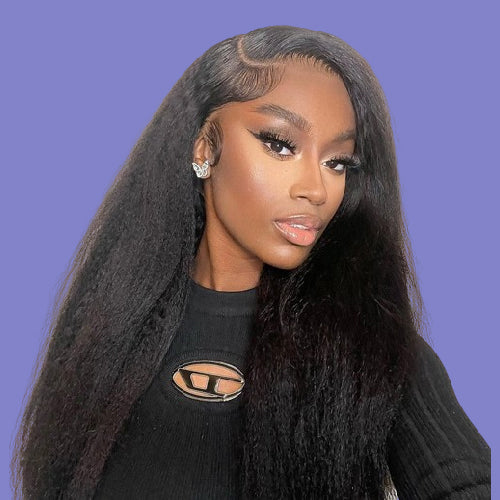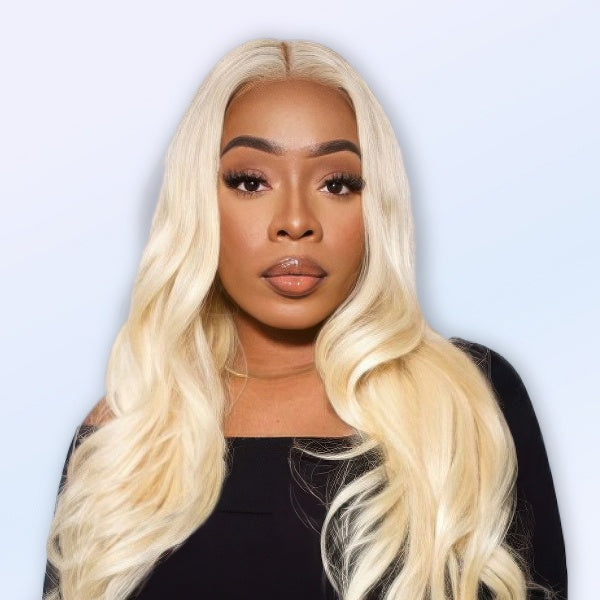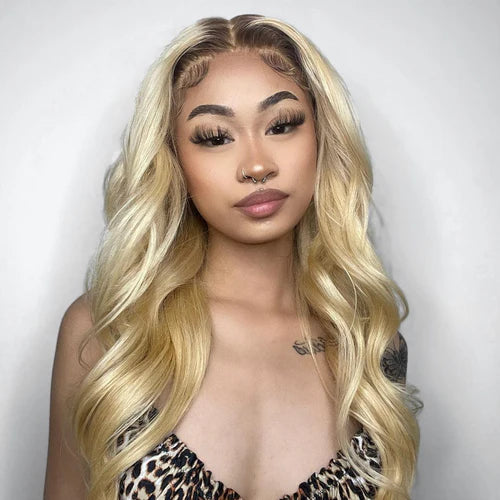How to Dye a Human Hair Wig
Transforming your human hair wig with a fresh, vibrant color can completely reinvent your look. Dyeing your wig is an exciting adventure, but it's not just about picking a color and hoping for the best. The secret to stunning results lies in mastering the right techniques and choosing the perfect products. Whether you're aiming for a subtle change or a bold statement, your success hinges on these two crucial elements. The right technique ensures even color distribution and minimizes damage, while proper product selection can mean the difference between a vibrant, long-lasting hue and a dull, faded disappointment.
What Type of Wig Is Best for Dyeing?

Virgin Human Hair Wigs: The Ideal Choice
Virgin human hair wigs are the gold standard for dyeing projects. These wigs are made from hair that has never been chemically treated, offering several advantages:
- Purity: The hair cuticles are intact, allowing for better dye absorption and more vibrant results.
- Versatility: Virgin hair can be dyed to almost any color, including lighter shades.
- Longevity: The dye job tends to last longer due to the hair's uncompromised structure.
When working with virgin hair, you'll find that the dyeing process is smoother and more predictable, often yielding professional-looking results.
Non-Virgin Human Hair Wigs: Limitations to Consider
While non-virgin human hair wigs can still be dyed, they come with some limitations:
- Previous processing may affect how well the hair accepts new color.
- Lifting to a lighter shade can be challenging and may result in brassiness.
- The hair may be more prone to damage during the dyeing process.
If you're working with a non-virgin wig, consider opting for darker shades or tones similar to the wig's current color for best results.
Synthetic Wigs: Unsuitable for Traditional Dyeing Methods
Synthetic wigs are not suitable for traditional hair dye methods. Here's why:
- Composition: Synthetic fibers are made of plastic and don't have the porous structure of human hair.
- Heat sensitivity: Many dyeing processes involve heat, which can melt or damage synthetic fibers.
- Color limitations: Even specialized synthetic hair dyes offer limited color options and often yield unpredictable results.
For these reasons, it's best to purchase synthetic wigs in your desired color rather than attempting to dye them.
Essential Steps Before Dyeing Human Hair Wigs

1. Assemble Your Dyeing Kit
Before you begin your wig transformation journey, gather all the necessary tools and materials. Here's a comprehensive checklist to ensure you're fully prepared:
- Hair dye (specifically formulated for human hair)
- Developer (10 or 20 volume, depending on your desired result)
- Mixing bowl and applicator brush
- Protective gloves
- Wig stand or mannequin head
- Old towels or cape to protect your workspace
- Plastic wrap for covering the dyed wig
- Color-safe shampoo and conditioner
Once you have all your supplies, set up a dedicated workspace. Choose an area with good lighting and ventilation. Cover surfaces with old towels or newspapers to prevent stains. Having everything within reach will make the dyeing process smoother and more enjoyable.
2. Choose the Perfect Hue
Your skin tone plays a crucial role in selecting a flattering hair color. Determine whether you have warm, cool, or neutral undertones. Warm skin tones often look best with golden, copper, or honey hues. Cool skin tones complement ash, platinum, or jewel-toned shades. If you have a neutral undertone, you're in luck – most colors will suit you well.
While skin tone is important, don't forget to factor in your personality and current fashion trends. Bold, vibrant colors can make a statement, while subtle, natural shades offer versatility. Consider your lifestyle and how often you're willing to maintain your wig's color.
Not all dyes are created equal. Avoid using products not specifically designed for human hair wigs. Box dyes meant for natural hair can be too harsh and may damage your wig's delicate fibers. Opt for professional-grade hair dyes or consult with a wig specialist for recommendations.
How to Choose and Mix the Right Hair Dye for Your Human Hair Wig
1. Select Your Ideal Shade
When dyeing your human hair wig, you have a spectrum of options from subtle, natural tones to bold, eye-catching hues. Darker shades often provide a rich, sophisticated look that's easy to maintain and can add depth to your appearance. Vibrant colors like reds, purples, or pastels can be a fantastic way to express your personality and stand out.
Your skin's undertone plays a crucial role in determining flattering colors. Warm undertones pair well with golden or copper hues, while cool undertones complement ash or platinum shades. Those with neutral undertones have the flexibility to experiment with most colors. Remember, these are guidelines, not rules. The best color is one that makes you feel confident and beautiful.
2. Create Your Custom Color Mix
Once you've chosen your shade, it's time to prepare the dye. This step is crucial for achieving consistent, long-lasting color. The developer you choose affects how much the dye will lighten your wig and how well the color will penetrate the hair. A 10 volume developer is ideal for depositing color without lightening, while a 20 volume is suitable for lifting color by 1-2 levels and for better gray coverage. For most wig dyeing projects, a 10 or 20 volume developer is sufficient.
To mix your dye, start by putting on gloves to protect your skin. In a plastic or glass bowl, combine the hair color and developer according to the manufacturer's instructions, typically in a 1:1 ratio. Use an applicator brush to mix thoroughly, ensuring no clumps remain. The final consistency should be smooth and creamy, not too runny or too thick.
How Do You Apply Hair Dye to Your Human Hair Wig?

1. Prepare Your Wig for Dyeing
Before you begin the dyeing process, proper preparation is key. Start by mounting your wig on a stand or mannequin head. This provides stability and allows you to work with ease. Next, use clips to section the hair into manageable parts. This ensures even coverage and prevents missed spots.
To protect the delicate lace front or base of your wig, apply a thin layer of petroleum jelly along the edges. This creates a barrier that prevents the dye from staining these sensitive areas.
2. Master the Dyeing Process
Before applying dye to the entire wig, conduct a strand test. Apply the dye mixture to a small, inconspicuous section of hair. This allows you to check the color accuracy and determine the ideal processing time.
You have two main options for applying dye: the soaking method and brush application. Soaking is ideal for achieving an all-over color, while brush application is perfect for creating highlights, lowlights, or ombre effects. For more diverse styles, you can combine these methods. For instance, you might soak the wig for a base color, then use brush application to add dimension with highlights.
Once you've applied the dye, timing becomes crucial. Follow the manufacturer's instructions for processing time, typically ranging from 20 to 45 minutes. Check the color periodically by wiping a small section of hair clean. This allows you to achieve your desired level of saturation without over-processing.
How to Care for Your Human Hair Wig After Dyeing
1. Cleanse Your Newly Dyed Wig
After the dyeing process, proper cleaning is crucial to remove any excess color and set the new hue. Use a specialized shampoo designed for color-treated hair to gently cleanse your wig. Avoid harsh rubbing or twisting motions that could damage the hair fibers. Instead, work the shampoo through the hair with light, downward strokes, focusing on one section at a time.
2. Nourish and Rinsing for Color Longevity
Once cleansed, apply a color-safe conditioner to replenish moisture and lock in the new shade. Concentrate on the mid-lengths and ends of the hair, avoiding the wig's base to prevent loosening of the knots. When rinsing, use cool water to help close the hair cuticles and seal in the color. Continue rinsing until the water runs clear, ensuring all product residue is removed.
3. Dry and Styling Your Freshly Dyed Wig
Begin by gently blotting the wig with a soft, clean towel to remove excess water. Avoid rubbing, as this can cause frizz and tangling. Allow the wig to air dry on a wig stand if time permits, as this is the gentlest method.
If you need to style your wig quickly, use a blow dryer on a low heat setting. Keep the dryer moving constantly to prevent heat damage, and use a wide-toothed comb to detangle as you dry. Once the wig is completely dry, style as desired, remembering to use heat protectant products if you plan to use hot styling tools.
Dye Your Human Hair Wig Properly!
Dyeing your human hair wig is an exciting opportunity to transform your appearance and express your unique style. By following the essential steps, from choosing the right wig type and shade to mastering the application and care techniques, you can achieve stunning, professional-looking results. Whether you opt for a subtle change or a bold statement, dyeing your wig allows you to experiment with different looks and find the perfect color that makes you feel confident and beautiful. Therefore, gather your tools, select your ideal hue, and embark on a journey of self-expression through the art of wig dyeing.







Leave a comment